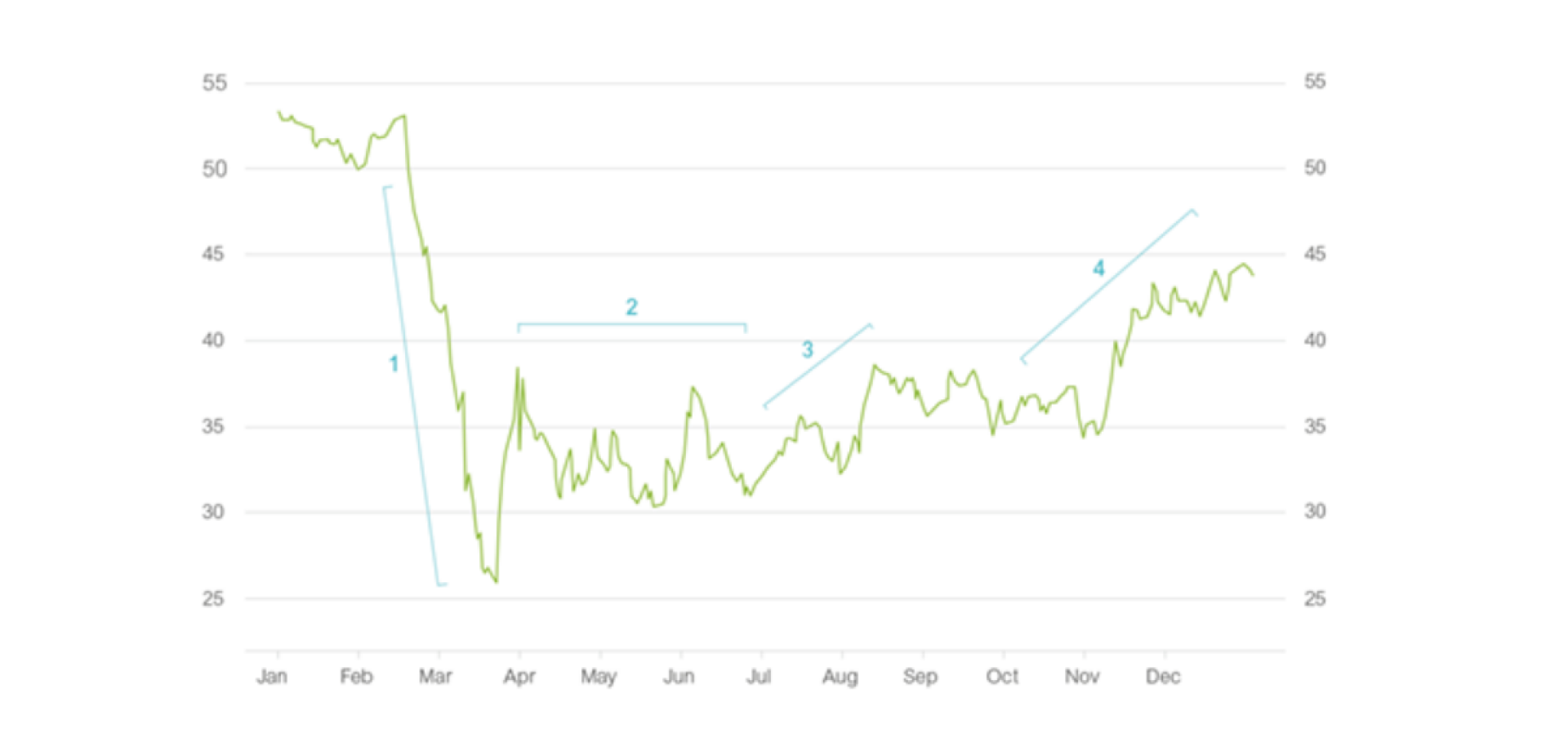How Ageas navigated through the 2020 financial turbulence
Christophe Boizard, Chief Financial Officer (CFO) of Ageas, reflects on the highs and lows of 2020.

2020 was an eventful year. As CFO how do you look back on it?
With the COVID- 19 pandemic, 2020 was firstly a tough year for everyone on a personal level. The economy was severely affected, and some sectors were impacted more than others. The insurance sector had to face a high volume of requests for pay-outs against specific covers like business interruption and event cancellations. But, thankfully, due to our risk profile mainly oriented towards personal lines, our exposure was marginal. But just like other companies, we were certainly hit by the sudden drop in the financial markets in March and April. And while the equity markets recovered sharply, real estate is still something we pay close attention to, monitoring in particular sectors like retail and the commercial centres.
Despite the uncertainty, we knew we would not be facing the challenges completely unarmed thanks to the Group’s strong cash position. It is exactly in these types of situations that our company is really put to the test. Thankfully, we can look back on 2020 confident that we were able to demonstrate financial resilience in the toughest conditions.
The equity markets also saw quite some impact over the course of the year. How did it impact Ageas’s share price?
Like many of our peers, the pandemic had a big impact on our share price. We saw a strong dip in March as the pandemic caught hold, causing a collapse in the equity markets and, within a few short weeks, this translated to a 50% drop from the initial value of EUR 53.10 seen at the beginning of the year. As an insurer the market also assumed an increase in insurance claims related to the economic slowdown, a negative impact on our investment portfolio reflecting potential defaults of corporate bond issuers and the collapse of the equity markets in general. But at the same time, having a balanced portfolio spanning Life and Non-Life and not being involved in some of the more troubled covers, was a clear advantage for Ageas.
In addition, shareholders had concerns about the dividend payment, following the guidance issued by the European and Belgian regulators to insurance companies to skip or postpone dividends and share buy-backs. Following a thorough risk analysis and thanks to our solid position, ultimately, we were able to deliver a 2019 dividend of EUR 2.65 in total, as announced earlier in the year when we disclosed the 2019 annual results.
As the year progressed, our investor community reacted positively to our commitment to pay the dividend announced in February before the restrictions imposed by the regulators, and to our continued strong operating performance and our solid solvency and cash positions. This led to a material rebound of the share price, which increased gradually through the second half of 2020 to EUR 44.45.
Analysts also reflected this in their reports, with 12 out of 18 providing a positive recommendation. We also received significant upgrades from the rating agencies S&P and Moody’s, and Fitch affirmed its strong ‘A+’ rating.
Can you tell us more about these ratings and the factors that influenced them?
S&P and Moody’s upgraded the rating of Ageas in 2020. In fact, despite the COVID-19 outbreak, Ageas was the only European insurer to receive a rating upgrade not linked to a merger or acquisition from S&P or Moody’s. In my view, this was due to three main drivers. Firstly, we entered the reinsurance space in 2019, enhancing our capital management, helping protect our business in case of unforeseen events. Secondly, we solved almost all our legacies from the past. And lastly, we continued to deliver a stable financial performance, outperforming analysts’ expectations.
How did we benefit from these upgrades?
Firstly, for our shareholders, these upgrades provided a level of confidence in the strength of the Group despite the unfolding financial turmoil around the world. On a more practical level this also allowed us to issue debt at more favourable conditions. In November, Ageas issued a EUR 500 million Tier 2 Notes, the third issuance in less than two years bringing EUR 1.75 billion of cash to the company at very favourable conditions (coupon of 1.875%). This increased our Solvency ratio allowing for new investments and acquisitions.
Connect21, the Group’s three-year strategic plan is now in its final year, how is Ageas doing against the targets it set itself?
With the exception of the Unit-Linked operating margin remaining slightly below target and on which we continue to focus our efforts, all our Connect21 targets will be comfortably reached.
That does not mean we can rest on our laurels… In 2021, we will intensify our efforts to prepare for the implementation of the future accounting standard IFRS 17. This will be quite a revolution in the way the industry will report on performance and results. In parallel, we will further optimise the capital management of the Group through improved fungibility of capital and enhanced asset & liability management.

Evolution of Ageas's share price in 2020 (in EUR)
- Rapid fallback due to uncertainty related to the COVID-19 pandemic. On 23 March the share price stood at its lowest level at EUR 25.30 per share.
- Markets remained volatile through spring, driven by uncertainty around the economic recovery after the pandemic
- The investment community responded positively to Ageas's half year results, gaining confidence based on the longer-term sound performance of the Group, and the confirmation of a dividend payment.
- Impact from positive outlook around the pandemic, more specifically vaccines.